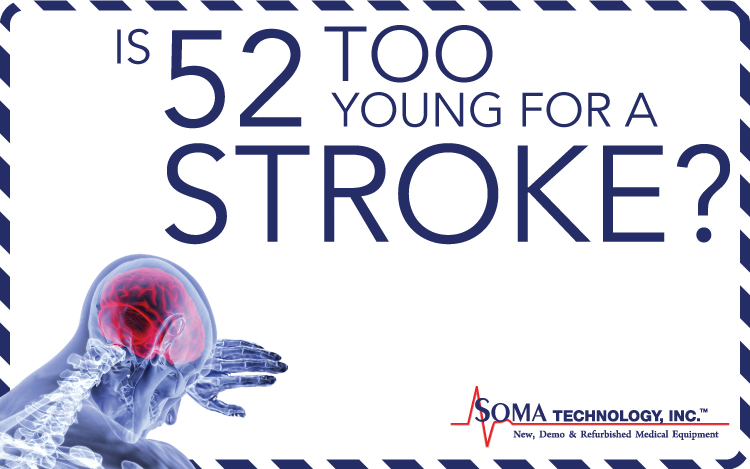Is 52 Too Young for a Stroke?
March 5, 2019
Is 52 Too Young for a Stroke?
Recently, teen idol Luke Perry died from a stroke at the age of 52. Perry was an American actor from the famous TV Series Beverly Hills, 90210. This has quite a few individuals puzzled thinking that 52 is too young for a stroke, but is it?
A stroke is an ailment that affects the arteries leading to and within the brain. Strokes are the 5th leading cause of death in the United States. A stroke occurs when a blood vessel that carries oxygen and nutrients to the brain is either blocked by a clot or bursts. When this happens, certain parts of the brain are unable to get the necessary blood flow and oxygen needed. There are four common types of strokes:
- An ischemic stroke is caused by a clot obstructing the flow of blood and oxygen to the brain.
- A hemorrhagic stroke is caused by a rupturing blood vessel which also halts the flow of blood and oxygen to certain parts of the brain.
- A transient ischemic attack, commonly referred to as a mini-stroke, is caused by a temporary clot in your blood vessels.
- A cryptogenic stroke is a stroke of unknown cause.
Continue reading to learn more about strokes.
Can Young Adults and Adolescents Have Strokes?
In 2017, a study by the American Academy of Neurology stated: “Approximately 15% of all ischemic strokes (IS) occur in young adults and adolescents.” Strokes in younger adults have a bigger economic impact that leaves these victims disabled before the more active years of their lives. The lack of research on strokes in young adults and adolescents makes it difficult to diagnose the symptoms in these individuals. Even after arriving at the emergency room or clinic, diagnosis is often delayed or missed entirely because some physicians consider strokes a disease for older patients.
Risk Factors for Strokes
Some risk factors for strokes can be changed by altering your lifestyle. Other factors that put you at risk can’t be changed.
- High blood pressure.
- Smoking or chewing tobacco. Nicotine makes your blood pressure go up, and cigarette smoke causes fatty buildup in your main neck artery.
- Heart Disease.
- Diabetes.
- Certain medications.
Signs and Symptoms of a Stroke
During a stroke, every minute counts. The faster you can get treatment, the less brain damage a stroke can cause. Here are some symptoms of strokes:
- Confusion, trouble speaking, or difficulty understanding speech.
- Numbness in the face, arm, or legs.
- Trouble seeing.
- Dizziness, loss of balance or coordination.
- Sudden severe headache.
It’s important to call 9-1-1 right away if you or someone you know starts showing signs of a stroke. Once the ambulance comes to bring you to the hospital, the paramedics can begin life-saving treatment on the way to the emergency room.
There is a quick and easy way to help diagnose if someone is having a stroke. Remember a FAST diagnosis could be life-saving when dealing with a stroke. Just remember the word F.A.S.T. and you can do this quick test.
- F is for face, ask the person to smile. Does one side of their face droop lower than the other?
- A is your arms, ask the person to raise both arms. Does one arm drift down?
- S is for speech, ask the person to repeat a simple phrase. Is the speech slurred or strange?
- T is for time. If you see any of these signs, be sure to call 9-1-1 right away.
Take a mental note when you first notice these signs. This information will help emergency physicians determine the best treatment for the individual. The stroke treatments that work best are available only if the stroke is recognized and diagnosed within 3 hours of the first symptoms.
Have you ever had a stroke, seen a stroke, or treated a stroke? Did we miss any important tips? Comment them below!
Explore Other Blog Items By Category
Recent Posts


Surgical Microscope Rentals

